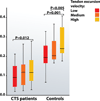The effect of tendon excursion velocity on longitudinal median nerve displacement: differences between carpal tunnel syndrome patients and controls
- PMID: 25640903
- PMCID: PMC5168720
- DOI: 10.1002/jor.22804
The effect of tendon excursion velocity on longitudinal median nerve displacement: differences between carpal tunnel syndrome patients and controls
Abstract
The subsynovial connective tissue (SSCT) is a viscoelastic structure connecting the median nerve (MN) and the flexor tendons in the carpal tunnel. Increased strain rates increases stiffness in viscoelastic tissues, and thereby its capacity to transfer shear load. Therefore, tendon excursion velocity may impact the MN displacement. In carpal tunnel syndrome (CTS) the SSCT is fibrotic and may be ruptured, and this may affect MN motion. In this study, ultrasonography was performed on 14 wrists of healthy controls and 25 wrists of CTS patients during controlled finger motions performed at three different velocities. Longitudinal MN and tendon excursion were assessed using a custom speckle tracking algorithm and compared across the three different velocities. CTS patients exhibited significantly less MN motion than controls (p ≤ 0.002). While in general, MN displacement increased with increasing tendon excursion velocity (p ≤ 0.031). These findings are consistent with current knowledge of SSCT mechanics in CTS, in which in some patients the fibrotic SSCT appears to have ruptured from the tendon surface.
Keywords: carpal tunnel; flexor tendons; median nerve; ultrasound; velocity.
© 2015 Orthopaedic Research Society. Published by Wiley Periodicals, Inc.
Conflict of interest statement
None.
Figures




Similar articles
-
Transverse plane tendon and median nerve motion in the carpal tunnel: ultrasound comparison of carpal tunnel syndrome patients and healthy volunteers.PLoS One. 2012;7(5):e37081. doi: 10.1371/journal.pone.0037081. Epub 2012 May 11. PLoS One. 2012. PMID: 22606333 Free PMC article.
-
Development of a kinematic model to predict finger flexor tendon and subsynovial connective tissue displacement in the carpal tunnel.Ergonomics. 2015;58(8):1398-409. doi: 10.1080/00140139.2015.1013575. Epub 2015 Mar 16. Ergonomics. 2015. PMID: 25679821
-
Relative displacement of the tendon and subsynovial connective tissue using ultrasound captures different phenomena than mechanical tendon shear.J Biomech. 2016 Nov 7;49(15):3682-3687. doi: 10.1016/j.jbiomech.2016.09.038. Epub 2016 Oct 6. J Biomech. 2016. PMID: 27745892
-
The biomechanics of subsynovial connective tissue in health and its role in carpal tunnel syndrome.J Electromyogr Kinesiol. 2018 Feb;38:232-239. doi: 10.1016/j.jelekin.2017.10.007. Epub 2017 Oct 24. J Electromyogr Kinesiol. 2018. PMID: 29108853 Free PMC article. Review.
-
Utility of Ultrasound Elastography in Evaluation of Carpal Tunnel Syndrome: A Systematic Review and Meta-analysis.Ultrasound Med Biol. 2019 Nov;45(11):2855-2865. doi: 10.1016/j.ultrasmedbio.2019.07.409. Epub 2019 Aug 9. Ultrasound Med Biol. 2019. PMID: 31402226
Cited by
-
Impaired median nerve mobility in patients with carpal tunnel syndrome: a systematic review and meta-analysis.Eur Radiol. 2023 Apr;33(4):2378-2385. doi: 10.1007/s00330-022-09262-9. Epub 2022 Nov 17. Eur Radiol. 2023. PMID: 36394604
-
Ultrasonographical Evaluation of the Median Nerve Mobility in Carpal Tunnel Syndrome: A Systematic Review and Meta-Analysis.Diagnostics (Basel). 2022 Sep 28;12(10):2349. doi: 10.3390/diagnostics12102349. Diagnostics (Basel). 2022. PMID: 36292039 Free PMC article.
-
Successful evaluation of a new image-based parameter for the diagnosis of carpal tunnel syndrome: ultrasound assessment of longitudinal median nerve gliding in patients, healthy volunteers, and cadavers.Eur J Phys Rehabil Med. 2024 Aug;60(4):671-679. doi: 10.23736/S1973-9087.24.08491-0. Epub 2024 Jul 15. Eur J Phys Rehabil Med. 2024. PMID: 39007786 Free PMC article.
-
Carpal tunnel syndrome treatment and the subsequent alterations in tendon and connective tissue dynamics.Clin Biomech (Bristol). 2021 Aug;88:105440. doi: 10.1016/j.clinbiomech.2021.105440. Epub 2021 Jul 24. Clin Biomech (Bristol). 2021. PMID: 34329857 Free PMC article.
-
An ultrasound study of the mobility of the median nerve during composite finger movement in the healthy young wrist.Muscle Nerve. 2022 Jan;65(1):82-88. doi: 10.1002/mus.27437. Epub 2021 Oct 27. Muscle Nerve. 2022. PMID: 34648193 Free PMC article.
References
-
- Korstanje JW, Scheltens-De Boer M, Blok JH, et al. Ultrasonographic assessment of longitudinal median nerve and hand flexor tendon dynamics in carpal tunnel syndrome. Muscle Nerve. 2012;45:721–729. - PubMed
-
- Hough AD, Moore AP, Jones MP. Reduced longitudinal excursion of the median nerve in carpal tunnel syndrome. Arch Phys Med Rehabil. 2007;88:569–576. - PubMed
-
- Guimberteau JC, Delage JP, Wong J. The role and mechanical behavior of the connective tissue in tendon sliding. Chir Main. 2010;29:155–166. - PubMed
-
- Cobb TK, Dalley BK, Posteraro RH, et al. The carpal tunnel as a compartment. An anatomic perspective. Orthop Rev. 1992;21:451–453. - PubMed
Publication types
MeSH terms
Grants and funding
LinkOut - more resources
Full Text Sources
Other Literature Sources
Medical
Research Materials

